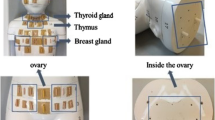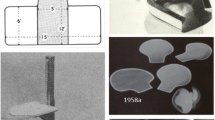Abstract
A total of 60 patients, divided into 3 groups with 20 patients in each, were examined with 3 different techniques: group 1 — conventional technique, exposure at 120 kV; group 2 — double-contrast technique (hypotonic gastrography, HG), exposure at 80 kW; group 3 — HG, exposure at 120 kV.
All examinations were performed in the same examination room and by the same radiologist. Absorbed doses to skin, thyroid, breasts, and gonads as well as energy imparted were measured. The only significant dose enhancements found when using double-contrast instead of conventional technique were in the female breasts and then only if the voltage was in the lower range. With exposure at 120 kV there was little difference in absorbed dose, but a significant advantage with respect to energy was imparted when using a double-contrast technique instead of a conventional technique. The testes doses were very low in all 3 types of examinations, and it seems that use of a testes shield is hardly motivated. With regard to both diagnostic accuracy and patient radiation dose, there can be no reason to use a conventional technique for upper GI examinations.
Similar content being viewed by others
References
Gustafsson M, Mortensson W: Radiation doses to children at urologic radiography.Acta Radiol 22:337–348, 1981
Seelentag W, Klotz E: Die Streustrahlung im Körper bei StrahlenqualitÄten von 50 bis 200 kV Erzeugerspannung.Strahlentherapie 108:112–126 (1959), as cited by: Lorenzon L.:Handbok i röntgenstrålskydd (in Swedish) 1975
Carlsson C: Determination of integral absorbed dose from exposure measurements.Acta Radiol 1:433–458, 1963
Carlsson C: Integral absorbed doses in roentgendiagnostic procedures. I. The dosemeter.Acta Radiol 3:310–326, 1965
Bengtsson G, Blomgren P-C, Bergman K, åberg L: Patient exposures and radiation risks in Swedish diagnostic radiology.Acta Radiol 17:81–105, 1978
Carlsson C: Integral absorbed doses in roentgendiagnostic procedures. II. Measurements of integral doses in two roentgendiagnostic departments.Acta Radiol 3:384–408, 1965
Carlsson C, Kaude J: Integral doses in 70-mm fluoroscopy of the gastrointestinal tract.Acta Radiol 8:84–88 1967
Holm T, Kaude J: Ventrikelundersökning med bildförstÄrkarfluorografi (in Swedish).LÄkartidningen 65:359–371, 1968
Gustafsson M: Energy imparted in roentgen diagnostic procedures.Acta Radiol Diagn 20:123–144, 1979
Cotton P: Fiberoptic endoscopy and the barium meal — results and implications.Br Med J 2:161–165, 1973
Gyepes MT, Smith LE, Ament ME: Fiberoptic endoscopy and upper gastrointestinal series: Comparative analysis in infants and children.AJR 128:53–56, 1977
Herlinger H, Glanville JN, Kreel L: An evaluation of the double contrast barium meal (DCBM) against endoscopy.Clin Radiol 28:307–314, 1977
Montagne J, Moss AA, Margulis AR: Double blind study of single and double contrast upper gastrointestinal examinations using endoscopy as controlAJR 130:1041–1045, 1978
Owman T, Eriksson S: Diagnostic accuracy of hypotonic gastrography — a comparison with gastroscopy. (to be published)
Author information
Authors and Affiliations
Rights and permissions
About this article
Cite this article
Bankvall, G., Owman, T. Patient radiation doses in upper GI examinations: A comparison between conventional and double-contrast techniques. Gastrointest Radiol 7, 231–234 (1982). https://doi.org/10.1007/BF01887644
Received:
Accepted:
Issue Date:
DOI: https://doi.org/10.1007/BF01887644




